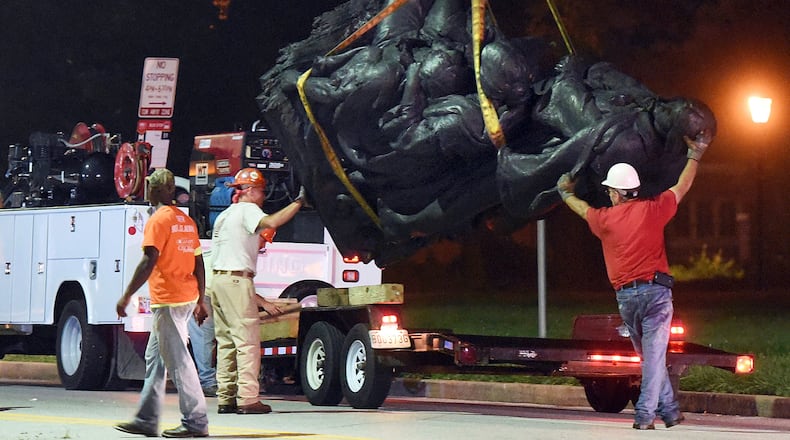Noon update: President Trump this morning decried efforts across the country to remove Civil War monuments. In a series of tweets, Trump said: "Sad to see the history and culture of our great country being ripped apart with the removal of our beautiful statues and monuments. You can't change history, but you can learn from it. Robert E Lee, Stonewall Jackson - who's next, Washington, Jefferson? So foolish!"
4 p.m. update: House Democratic leader Nancy Pelosi today called for the removal of all Confederate statues from the U.S. Capitol, including one of Alexander Stephens of Georgia. "The Confederate statues in the halls of Congress have always been reprehensible," Pelosi said. "If Republicans are serious about rejecting white supremacy, I call upon Speaker Ryan to join Democrats to remove the Confederate statues from the Capitol immediately."
Each state is permitted to contribute two statues to the National Statuary Hall in the Capitol. At least six of the statues represent Confederate figures.
Our earlier report begins here:
Monumental change is once again sweeping the South. Massive memorials disappear in the dark of night. Statues that have stood for decades stand no longer. A history once etched in stone is being scrubbed away.
In the days since the racial violence in Charlottesville, crosshairs have appeared on granite and marble all over the region:
- Baltimore: the city removed four Confederate monuments without notice Tuesday night.
- Richmond: Mayor Levar Stoney said Wednesday that events in Charlottesville had convinced him that the city should remove the five massive memorials lining Monument Avenue.
- Gainesville, Fla.: the Daughters of the Confederacy opted to take down their 113-year-old statue of "Old Joe."
- Birmingham: the city concealed a monument to Confederate soldiers and sailors by putting tarps and plywood around it. The state promptly sued.
- Durham, N.C.: at least three more people were arrested Wednesday in the toppling of a Confederate statue that had presided over the old county courthouse for more than 90 years.
- Nashville: in the Tennessee State Capitol, protesters draped a jacket over the bust of the infamous Nathan Bedford Forrest — Confederate general, slaveholder, Klan grand wizard — and chanted, "Tear it down!"
And here in Georgia, of course, a gubernatorial candidate proposed the destruction of the biggest Confederate memorial in the galaxy — the massive carving at Stone Mountain. It’s so large, the park’s website reminds us, workers who created it could easily step into a horse’s mouth to escape a sudden shower. Meanwhile, a petition to remove the Confederate obelisk at the old DeKalb County courthouse neared 2,000 signatures on Wednesday. But one of the most defiant pro-Confederacy memorials outside of Stone Mountain — the Augusta Confederate Monument — seemed to be gathering more pigeons than detractors this week.
“Every time I go through downtown, I feel sad because it’s like we are stuck,” state Rep. Gloria Frazier, D-Hephzibah, said of the monument. “That’s why downtown is not progressing like it should… . You can’t have things and statues that are derogatory from the past to hinder what we are trying to do here.”
But Frazier and others said there seems little desire in the Garden City to change the landscape.
The Augusta monument, a 76-foot spire with life-sized statues of four Confederate generals at its base, bears the inscription: “No nation rose so white and fair. None fell so pure of crime.”
The words – taken from an English poet’s tribute to Robert E. Lee – are emblazoned on the granite base, with statues of Generals Lee, Stonewall Jackson, Thomas R.R. Cobb and William H.T. Walker looming over it. Perched high above them all is a statue of local enlisted solider Berry Benson, clutching the rifle he never gave up (he refused to attend Lee’s surrender at Appomattox).
Benson and the others have been fixtures in the Broad Street median for nearly 140 years. Today, they stand a block away from a statue of James Brown.
Trump: ‘Where does it stop?’
The regionwide removal movement came even as President Donald Trump was telling the nation that many demonstrators in Charlottesville simply wanted to preserve the state of Robert E. Lee.
“This week it’s Robert E. Lee. I notice that Stonewall Jackson’s coming down,” Trump said on Tuesday. “I wonder, is it George Washington next week, and is it Thomas Jefferson the week after? You know, you really do have to ask yourself, where does it stop?”
But statue stalkers seemed content to stop with Confederate figures for now.
» Andrew Young: Fights over monuments 'a mistake'
Work crews in Baltimore set equestrian statues of Lee and Jackson on a flatbed truck early Wednesday and drove them away. Also removed in the middle of the night was a statue of Roger B. Taney, the Supreme Court chief justice who wrote the Dred Scott decision. The 1857 ruling held that no black person was or could ever be a U.S. citizen.
Baltimore Mayor Catherine Pugh told the Washington Post she stayed up all night, monitoring the removal of the four monuments. “I said, ‘We want to do it tonight, away from fanfare,’” Pugh said. “We all are seeing lessons via the media of uprisings and violence, and violence is not what we need in our city.”
Carolyn Billups, former president of the Maryland chapter of the United Daughters of the Confederacy, told the Baltimore Sun she considered chaining herself to one of the statues.
“Rats run at night,” Billups told the Sun. “It’s very saddening, but at least the monuments were not torn down by angry mobs.”
‘We do have to own it’
If they wish to dismantle Civil War monuments, some states, including Georgia and North Carolina, will have to repeal state laws that prohibit the removal or relocation of historic statues.
Facing such a law in Alabama, Birmingham city officials placed black plywood over a statue of Confederate soldiers and sailors in Linn Park on Tuesday. On Wednesday, the state attorney general filed suit, saying, “By affixing tarps and placing plywood around the Linn Park Memorial such that it is hidden from view, the defendants have 'altered' or 'otherwise disturbed' the memorial in violation of the letter and spirit of the Alabama Memorial Preservation Act.”
And in Augusta, some observers said, there’s no political will to remove the Confederate Monument, anyway, because there’s no political benefit.
Brad Owens, a member of Augusta’s Urban Redevelopment Agency, noted that any battle over the monument would inevitably fall along racial lines, alienating voters and campaign donors.
But Owens, who is white, said the 19th century remnant needs to be dealt with. He suggests a compromise: Cover the “white and fair” inscription and put a new marker nearby putting the monument in context — how it went up when Civil War veterans and widows were still alive, and describing progress made over the ensuing century with civil rights and women’s rights.
“People have to accept the fact that, yes, the war was fought over slavery,” Owens said. “The South’s got to forgive themselves for that; the rest of the country’s got to forgive us for it. We have to move forward. But we do have to own it.”
The Associated Press, the New York Times, the Washington Post and the Baltimore Sun contributed reporting.
Are Southern Civil War monuments history?
- Baltimore (Wednesday): City removes four Confederate monuments without notice between 11 p.m. Tuesday and 5 a.m. Wednesday.
- Annapolis (Tuesday): Maryland governor calls for removal of Roger B. Taney monument (A different Taney statue was removed from Baltimore Wednesday).
- Atlanta (Tuesday): Democratic candidate Stacy Abrams calls for removal of the giant carving on Stone Mountain.
- Dallas (Monday): Mayor proposes a task force to study removal of Robert E. Lee equestrian statue.
- Jacksonville (Monday): City council president calls for removal of towering monument from city park to a museum.
- Charlottesville: (Saturday): Protesters clash with neo-Nazis seeking to stop the city from moving Robert E. Lee statue out of a city park.
- Louisville (May): University of Louisville removes towering Confederate monument, nearby town of Brandenburg gladly accepts it.
- New Orleans (April): Crews in flak vests, helmets and masks remove four monuments by night.
Credit: AP Photo/John Bazemore, File
Credit: AP Photo/John Bazemore, File
The Latest
Featured






